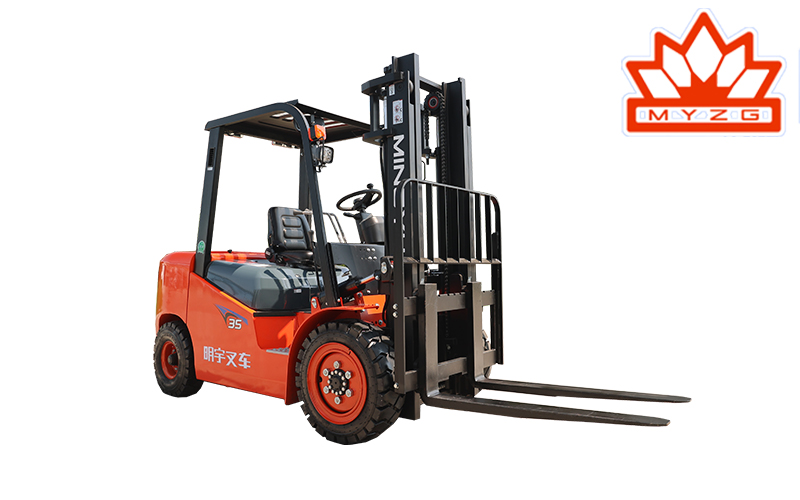
The drive axle housing of a diesel forklift is a critical component, rigidly attached to the forklift's frame. This connection means the drive axle bears a substantial portion of the weight, especially during load lifting, transport, and stacking operations. Furthermore, the drive axle is subjected to significant stress from uneven road surfaces and imbalanced loads. Consequently, the drive axle housing is susceptible to various forms of damage, including bending, fractures, wear in the half-shaft sleeve bearing holes, and wear on the half-shaft sleeve journals. Regular and thorough inspection of the drive axle housing is essential for maintaining forklift safety and operational efficiency. This detailed guide outlines the inspection procedures and corrective measures for common drive axle housing issues.

Understanding the Importance of Drive Axle Housing Integrity
The drive axle housing serves as the backbone of the forklift's rear axle assembly. It not only supports the weight of the load and a portion of the forklift itself, but also transmits power from the differential to the wheels. Its robust construction is vital for ensuring stability, maneuverability, and safe operation. Any damage to the drive axle housing can compromise these functions, leading to potential accidents, reduced productivity, and costly repairs. Therefore, a proactive approach to inspection and maintenance is paramount.
Inspection Procedures for Drive Axle Housing Bending
Bending of the drive axle housing is a common issue resulting from the stresses mentioned earlier. Detecting and addressing this problem promptly is crucial. The following steps detail the inspection procedure:
Preparation and Initial Assessment: Before commencing the bending inspection, it's essential to ensure the flatness of the axle shaft's flat contact flange and the hub end. This step is crucial for eliminating any circular runout error on the end face, which could skew the bending measurement. Any necessary corrections to these surfaces should be performed before proceeding.
Standard Axle Shaft Installation: A standard axle shaft should be carefully installed onto the drive axle housing. Properly tightening the bearings is essential for accurate measurements. Ensure the bearings are neither too loose nor too tight, as this can affect the readings.
Centering Measurement and Comparison: The next step involves measuring the center of both the left and right axle shafts from inside the housing. This measurement helps determine the extent of any bending. The difference between the centers of the two axle shafts is the key indicator of bending.
Tolerance Limits: The permissible difference between the two axle shaft centers should not exceed 0.75mm. If the difference exceeds this limit, it indicates that the drive axle housing is bent and requires correction.
Corrective Measures for Drive Axle Housing Bending
When the drive axle housing's bending exceeds the specified limit, corrective action is necessary. The following procedures outline the correction process:
Controlled Deformation: The correction process involves applying pressure to the bent housing to induce plastic deformation, effectively straightening it. It's crucial to ensure that the correction deformation does not exceed the original bending deformation. Over-correction can weaken the housing and lead to premature failure.
Sustained Pressure: After applying the correction pressure, it should be maintained for a specific period. This allows the axle housing to undergo the necessary plastic deformation and retain its new shape. The duration of pressure application depends on the severity of the bend and the material of the housing.
Preheating for Severe Bends: In cases where the bending deformation is significant (greater than 2mm), preheating the axle housing before correction can be beneficial. Preheating makes the metal more pliable, reducing the force required for correction and minimizing the risk of cracking.
Temperature Control: If preheating is employed, it's crucial to maintain strict temperature control. The heating temperature should never exceed 700°C. Exceeding this temperature can alter the metal's properties and significantly weaken the axle housing.
Cast Axle Housing Considerations: Cast axle housings require extra care during the correction process. They are more susceptible to cracking and distortion from heat and pressure. Heat correction is generally discouraged for cast axle housings, and alternative methods should be explored whenever possible. If heat correction is unavoidable, it should be performed by experienced professionals with specialized equipment.
Additional Inspection Points and Best Practices
Beyond the bending inspection, other aspects of the drive axle housing should be regularly checked:
At the end
The drive axle housing is a vital component of a diesel forklift, and its integrity is paramount for safe and efficient operation. Regular inspection, following the procedures outlined in this guide, is essential for detecting and addressing potential issues like bending. Proper corrective measures, performed with care and expertise, can restore the drive axle housing to its proper condition. By prioritizing inspection and maintenance, forklift owners and operators can ensure the longevity and reliability of their equipment, while also maintaining a safe working environment. Remember, if any significant damage is discovered, it is always best to consult with a qualified technician for expert assessment and repair.
Name: selena
Mobile:+86-13176910558
Tel:+86-0535-2090977
Whatsapp:8613181602336
Email:vip@mingyuforklift.com
Add:Xiaqiu Town, Laizhou, Yantai City, Shandong Province, China